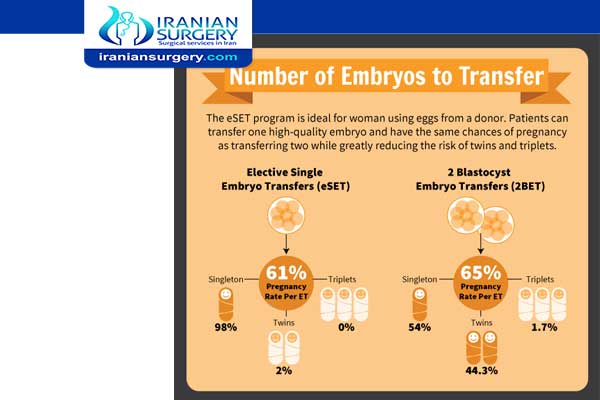2 blastocyst transfer success rate
Does transferring 2 embryos increase chances?
What is the success rate of blastocyst transfers?
Is it better to transfer one or two embryos?
2 blastocyst transfer success rate
Blastocyst transfers have a higher pregnancy rate than embryos transferred at an earlier stage (day 2 or 3). It's best practice to have only one embryo put back. Single embryo transfers don't affect success rates. Remaining good quality embryos can be frozen to use in any future treatment or donated.
Read more about: IVF in Iran
Read more about : Type of Infertility Treatment in Iran
Read more about : Egg donation in iran
Read more about: frozen embryo transfer with laser assisted hatching
Does transferring 2 embryos increase chances?
About 1% of implanting embryos will split into identical twins. As a result, even when “only” two embryos are transferred, triplet pregnancy can still occur. The risks of low birth weight and prematurity are not to be taken lightly. Transfer of two good looking blastocysts can result in twin pregnancy rates as high as 50%. Therefore, transferring only one should be considered in young women (or in egg donation cycles) with high-quality blastocysts.
Read more about 2nd iui success rate
Read more about Virgin tightening surgery before and after
Read more about Ovarian cyst size chart
Read more about: frozen embryo transfer step by step
What is the success rate of blastocyst transfers?
As the environment within the fallopian tube and uterus differ, blastocysts are much more suited to survival and development in the uterus. As a result, enhanced or equally successful pregnancy with blastocyst transfer is achieved with fewer embryos and a reduced incidence of multiple births.
Is it better to transfer one or two embryos?
Research still shows that transferring one embryo per cycle is the safest option. Transferring two increases the chance of a multiple pregnancy and associated complications. (Not by a huge margin, but the risk is still significant.)
Read more about: embryo hatching after thaw
Read more about: Blastocyst transfer success stories
10 common questions about 2 blastocyst transfer twin rate
[kkstarratings]



